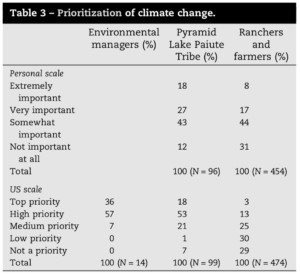Major climate change perception surveys have been conducted in the U.S within the last 20 years polls found that 57% (2009) and 59% (2010) of Americans believed that global warming was occurring. Few studies have focused on rural American climate change perceptions.
We will explore perceptions, knowledge and preferences regarding climate change in Nevada with people who have a personal connection to its local and sometime extreme environment. Surveys were made to the tribal groups located in Nevada to collect data about the tribal climate and risk perceptions. The tribal households were targeted through mail and house-to-house surveys distributed by a tribal member undergraduate researcher. Focusing on the tribes in Nevada gave them more insight of climate change in rural areas. The environmental managers (EM) survey response rate was 54%, they represent statewide tribal governmental perspectives, knowledge and action plans. The ranchers/farmers (RF) survey achieved a 26% response rate, which is solid for a survey-resistant group and lengthy survey.
The EM and RF have much in common in terms of education, both groups have major land and water management responsibilities. Differences in RF and PL (which is a Tribal group in Nevada) perspectives do no reflect major income disparities. Public opinion and risk perception regarding climate change are important in environmental policy and management modifications.
PL and RF sources of climate change information are dominated by television, although RF also receives sources from the internet and radio, which is often conservative in rural Nevada. The fundamental question regarding whether or not climate change exists and if human play a role is affirmative by about 3/4 of PL respondents. While 100% of EM believe climate change. Only 60% of Nevada’s farmers and ranchers agree that climate change is happening, and about 29% believe that human activity is a significant role.
Many Native Americans, like RF, spend most of their time on the land and water, which makes them valuable since they can observe the changes happening. The EM climate impacts observations are about 86% for decrease in snow packs and 79% earlier runoff. PL records three high marks in the same categories, and there are also same percentages for observing less surface water and less spring water. RF have lower percentages, close to half snow pack decreases, and a quarter of early melting and runoff, with the same for increasing temperatures in summer. However, they did find less surface water and less water from spring.
Americans’ awareness of global warming or climate change has risen since the 1980s, however the rise has been uneven. Factors as gender, martial status, and education have a moderate effect on the individual scientific knowledge of climate change. A greater percentage of women than man believed that climate change is happening, and that it is because of human activity. In recent years belief in climate change has drop, in 2010 only 57% of American adults felt climate change was happening, compare to 71% in 2008. There hasn’t been a lot of discussion about this topic recently so this may have had contributed to a decrease in belief.
This findings about climate change can be researched in a local level making it more meaningful and understandable to the public, even to those who are already decided this isn’t happening. This research proves a lot of point from different groups of different opinions, climate change being the only one each group agrees is happening. The observations of each group or tribal gives us basically the same results just different rates of how it is happening.
